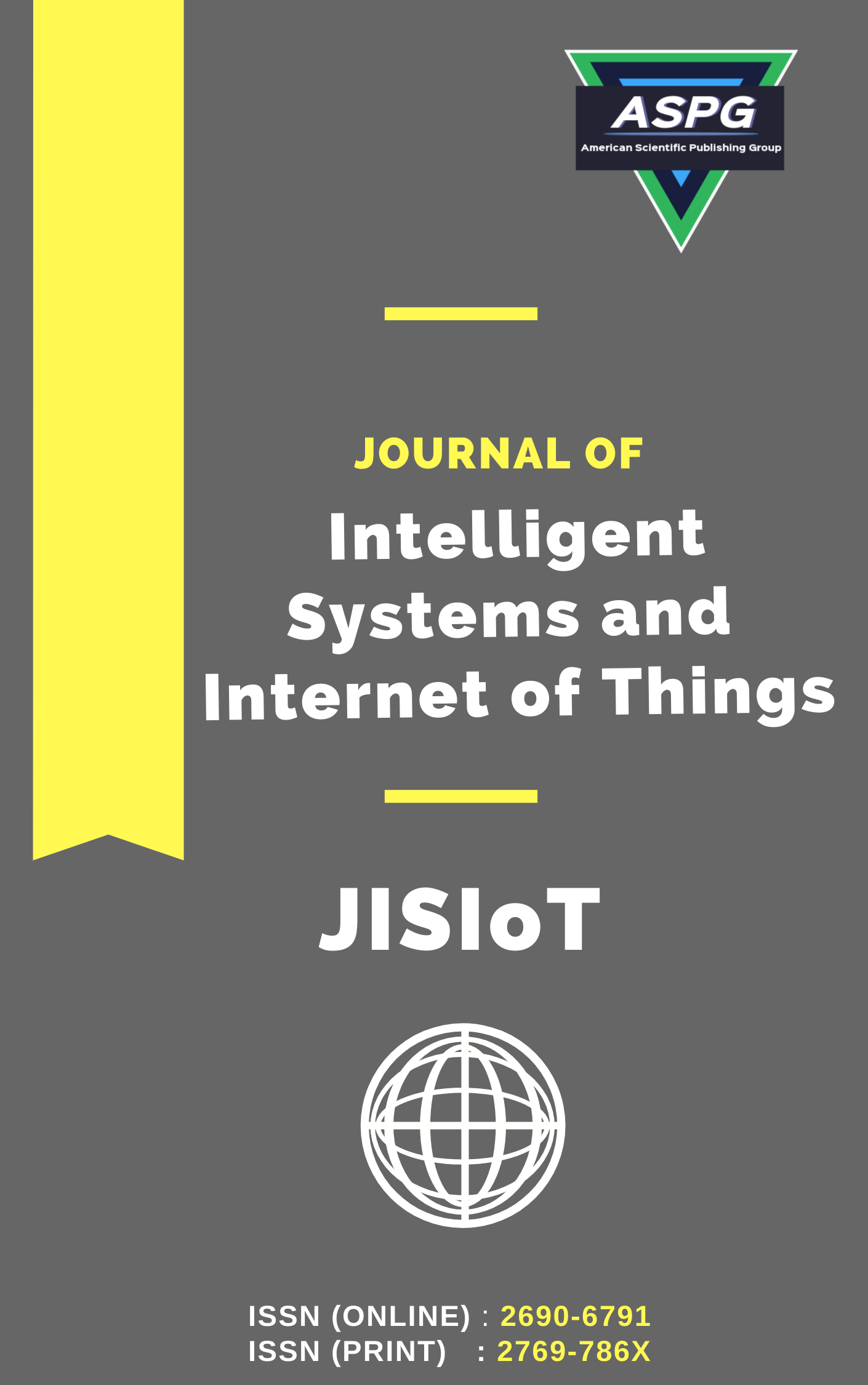

Volume 16 , Issue 1 , PP: 199-210, 2025 | Cite this article as | XML | Html | PDF | Full Length Article
P. Jagdish Kumar 1 * , S. Neduncheliyan 2
Doi: https://doi.org/10.54216/JISIoT.160117
Internet of things (IoT) is an intelligent combination of embedded systems, cloud computing and wireless communications. However, the data privacy and leakage problems are considered as the major deadlocks for deploying the IoT devices in the real time fields. Nevertheless, the complication of Distributed Denial of Service (DDoS) hazard on the IoT devices recent surge has seen an uptick, making it prone to numerous threat complications. For this reason, prompt detection of these attacks plays a pivotal role to safeguard the user’s data. The AI methodology of Machine and Deep Learning Models engaged for the designing the intelligent systems to provide the secured environment to safeguard the network against the various attacks. However, the computational overhead of deep learning model handicaps to deploy it in the IoT-Cloud environment. To tackle this issue, the present article suggests the novel hybrid learning based detection system called CAT-FEED-NETS that incorporates the Deep feed forward neural networks (DFFNN) where the hyper parameters are tuned by the Cat Swarm Intelligence Algorithms. Comprehensive trials and analysis are performed using NSL-KDD and UNSW datasets and criteria to assess the efficacy of quality measurements such as accuracy, precision recall, F1-score and model building time (MBT) is evaluated and analysed. Evaluation results are weighted against the various DL algorithms with the suggested model exhibiting better results than the other models by producing 0.96 accuracy, 0.956 precision, 0.955 recall and 0.9834s of MBT respectively. The proposed framework had proved its superiority in predicting the cloud attacks than the other existing frameworks.
Internet of things (IoT) , Machine Learning , Deep learning Algorithms , CAT-Swarm Optimization
[1] S. Huang, J. Su, S. Dai, C. Tai, and T. Lee, “Enhancement of wireless power transmission with foreign-object detection considerations,” in Proc. 2017 IEEE 6th Global Conf. Consumer Electronics (GCCE), Nagoya, Japan, 2017, pp. 1-2.
[2] S. Fukuda, H. Nakano, Y. Murayama, T. Murakami, O. Kozakai, and K. Fujimaki, “A novel metal detector using the quality factor of the secondary coil for wireless power transfer systems,” in Proc. 2012 IEEE MTT-S Int. Microwave Workshop Series on Innovative Wireless Power Transmission: Technologies, Systems, and Applications, Kyoto, Japan, 2012, pp. 241-244.
[3] L. Xiang, Z. Zhu, J. Tian, and Y. Tian, “Foreign object detection in a wireless power transfer system using symmetrical coil sets,” IEEE Access, vol. 7, pp. 44622-44631, 2019.
[4] A. Azad, V. Kulyukin, and Z. Pantic, “Misalignment tolerant DWPT charger for EV roadways with integrated foreign object detection and driver feedback system,” in Proc. 2019 IEEE Transportation Electrification Conf. and Expo (ITEC), Detroit, MI, USA, 2019, pp. 1-5.
[5] T. Sonnenberg, A. Stevens, A. Dayerizadeh, and S. Lukic, “Combined foreign object detection and live object protection in wireless power transfer systems via real-time thermal camera analysis,” in Proc. 2019 IEEE Applied Power Electronics Conf. and Exposition (APEC), Anaheim, CA, USA, 2019, pp. 1547-1552.
[6] S. A. Nabi, P. Kalpana, N. S. Chandra, L. Smitha, K. Naresh, A. E. Ezugwu, and L. Abualigah, “Distributed private preserving learning based chaotic encryption framework for cognitive healthcare IoT systems,” Informatics in Medicine Unlocked, vol. 49, p. 101547, 2024. DOI: 10.1016/j.imu.2024.101547.
[7] S. Jeong, T. Lin, and M. M. Tentzeris, “A real-time range-adaptive impedance matching utilizing a machine learning strategy based on neural networks for wireless power transfer systems,” IEEE Trans. Microwave Theory Techn., pp. 1-8, Sept. 2019. DOI: 10.1109/tmtt.2019.2938753.
[8] P. Kalpana, P. Srilatha, G. S. Krishna, A. Alkhayyat, and D. Mazumder, "Denial of service (DoS) attack detection using feed forward neural network in cloud environment," in Proc. 2024 Int. Conf. Data Science and Network Security (ICDSNS), Tiptur, India, 2024, pp. 1-4. DOI: 10.1109/ICDSNS62112.2024.10691181.
[9] N. Prosen, M. Milanovič, and J. Domajnko, “On-line foreign object detection using double DD coils in an inductive wireless power transfer system,” Sensors, vol. 22, no. 4, p. 1637, 2022. DOI: 10.3390/s22041637.
[10] Y. Wang, H. Wang, and Z. Peng, "Rice diseases detection and classification using attention-based neural network and Bayesian optimization," arXiv preprint arXiv: 2201.00893, 2022.
[11] Y. Gong, Y. Otomo, and H. Igarashi, “Machine learning-based metal object detection for wireless power transfer using differential coils,” J. Adv. Simulation Sci. Eng., vol. 9, no. 1, pp. 20-29, 2022. DOI: 10.15748/jasse.9.20.
[12] M. Wu, L. Guo, R. Chen, W. Du, J. Wang, M. Liu, X. Kong, and J. Tang, "Improved YOLOX foreign object detection algorithm for transmission lines," Wireless Commun. Mobile Comput., vol. 2022, Article ID 5835693, pp. 1-10, 2022. DOI: 10.1155/2022/5835693.
[13] P. Kalpana, R. Anandan, A. G. Hussien, H. Migdady, and L. Abualigah, “Plant disease recognition using residual convolutional enlightened Swin transformer networks,” Sci. Rep., vol. 14, p. 8660, 2024. DOI: 10.1038/s41598-024-56393-8.
[14] T. Munyer, D. Brinkman, X. Zhong, C. Huang, and I. Konstantzos, “Foreign object debris detection for airport pavement images based on self-supervised localization and vision transformer,” arXiv preprint arXiv: 2210.16901, 2022.
[15] R. J. Kuo and F. F. Nursyahid, “Foreign objects detection using deep learning techniques for graphic card assembly line,” J. Intell. Manuf., 2022. DOI: 10.1007/s10845-022-01980-7.
[16] D. H. Nguyen, G. Tumen-Ulzii, T. Matsushima, and C. Adachi, “Performance analysis of a perovskite-based thing-to-thing optical wireless power transfer system,” IEEE Photon. J., vol. 14, no. 1, pp. 1-8, 2022.
[17] A. Wu et al., “Mask R-CNN based object detection for intelligent wireless power transfer,” in Proc. 2018 IEEE Globecom Workshops (GC Wkshps), Abu Dhabi, United Arab Emirates, 2018, pp. 1-5. DOI: 10.1109/GLOCOMW.2018.8644387.
[18] J. Cha, W. Lee, G. Choe, and Y. Kim, “A method of the improvement of wireless power transfer (WPT) system efficiency, compatibility, EMI reduction, and foreign object detection (FOD) for EV applications,” SAE Tech. Paper 2020-01-0530, 2020. DOI: 10.4271/2020-01-0530.
[19] B. Wang, S. Huang, and J. Qiu, “Parallel online sequential extreme learning machine based on MapReduce,” Neurocomputing, vol. 149, pp. 224-232, 2015.